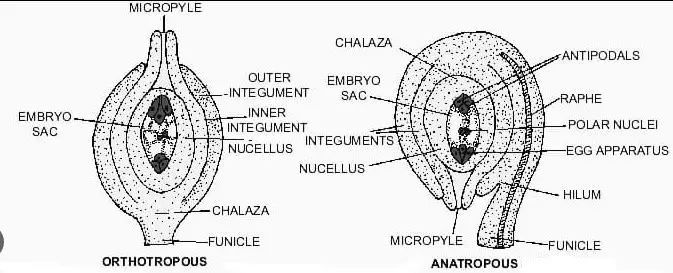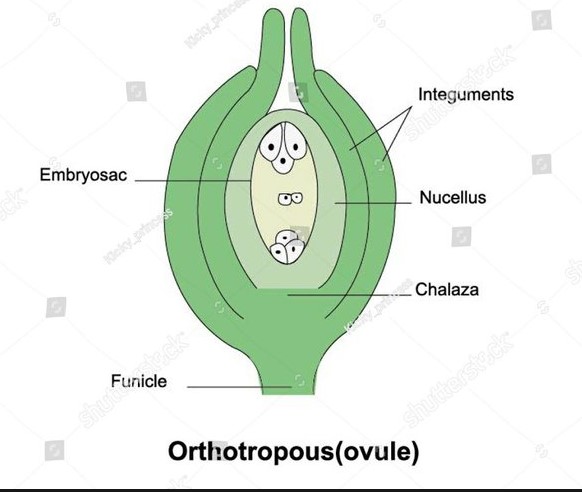Ovules are fundamental components of plant reproductive structures, yet their types and functionalities often go unnoticed outside of botanical sciences. Distinct types of ovules, specifically anatropous and orthotropous, play crucial roles in the way plants reproduce and evolve. Each type exhibits unique structural features that influence not only the reproductive success of the plant but also its adaptation to various ecological niches.
The anatropous ovule is the most common type found in flowering plants, characterized by its inverted position that results in the micropyle facing the placenta. In contrast, the orthotropous ovule remains upright, with its micropyle positioned directly opposite the placenta. These structural differences are pivotal in determining the mechanisms of fertilization and seed development in plants.
In discussing these two types of ovules, it is essential to explore their structural nuances, developmental processes, and the broader implications these have on plant biology. Such an understanding can illuminate the intricate dance of evolution and adaptation that shapes the world’s flora.

Ovule Basics
Definition and Function
In the realm of botany, an ovule serves as the precursor to a seed, fundamental in the reproductive system of seed plants. Enclosed within the ovary of a flower, the ovule plays a pivotal role in sexual reproduction. It houses the female gametophyte, where fertilization occurs, leading to the development of a seed after successful pollination and fertilization. This process is crucial for the genetic diversity and survival of plant species.
Role in Plant Reproduction
Ovules are not just passive structures; they actively participate in the reproduction of plants through several key functions:
- Protection: Ovules provide a secure environment where the female gametes can develop without the threat of environmental stressors.
- Nutrition: They supply the necessary nutrients to the developing embryo, which is vital for its growth into a healthy seed.
- Fertilization site: Serving as the site for fertilization, ovules ensure that the sperm reaches the egg cell, facilitating the fusion of male and female gametes.
Anatropous Ovule
Structural Characteristics
The anatropous ovule is distinguished by its unique inverted curvature. This ovule type is attached to the ovary wall at a point called the funiculus, while the body of the ovule turns back on itself, forming a structure known as the chalaza at its base. The curved structure leads the micropyle, initially positioned near the base, to face the placenta, facilitating easier access for the pollen tube during fertilization.
Developmental Process
The development of an anatropous ovule involves several stages:
- Initiation: It begins as a small bulge from the placenta, gradually forming the primordial structures.
- Curvature Formation: As it grows, the ovule bends to achieve its characteristic inverted position.
- Differentiation: Tissues differentiate into the integuments, nucellus, and the female gametophyte within the ovule.
Common Examples
Anatropous ovules are common in many flowering plants, including significant crops and ornamentals like:
- Roses
- Tomatoes
- Peas
These examples highlight the prevalence of anatropous ovules in diverse botanical families, showcasing their evolutionary success in various environments.
Orthotropous Ovule
Structural Characteristics
In contrast, the orthotropous ovule maintains a straight position, with its attachment point at the base directly opposite the micropyle. This alignment is considered the most primitive among ovule types, featuring a simple and direct layout that facilitates the direct entry of pollen tubes without the need for intricate pathways.
Developmental Process
The development process of an orthotropous ovule is straightforward:
- Formation: Begins as an outgrowth from the placenta.
- Growth: It grows upward, maintaining a linear alignment between the micropyle, nucellus, and chalaza.
- Maturation: As it matures, the protective integuments form around the nucellus, preserving the gametophyte inside.
Common Examples
Orthotropous ovules are typically found in plants such as:
- Cycads
- Ginkgo
- Magnolias
These examples demonstrate the orthotropous ovule’s persistence in both ancient gymnosperms and some specialized angiosperms, reflecting its fundamental role in the history of plant evolution.
Comparative Analysis
Physical Differences
A fundamental aspect that distinguishes anatropous and orthotropous ovules is their physical orientation within the ovary. The anatropous ovule, prevalent in most angiosperms, is notable for its inverted position. This orientation optimizes the pathway of the pollen tube to the egg, enhancing fertilization efficiency. Conversely, the orthotropous ovule, often observed in more primitive plants like cycads and magnolias, remains upright, presenting a straight alignment from the base to the micropyle. This simplicity suggests an evolutionary base line from which more complex ovule orientations may have evolved.
Biological Implications
The orientation of ovules in plants is not merely a structural characteristic but has deep biological implications affecting:
- Fertilization mechanics: The approach and entry of the pollen tube are significantly influenced by the orientation of the micropyle.
- Seed dispersal: The position and development of the ovule can affect how seeds are dispersed, influencing ecological distribution and competition.
- Embryo protection: The structural complexity of anatropous ovules provides enhanced protection to the developing embryo, which can be critical in hostile environmental conditions.
Evolutionary Perspective
Evolution of Ovule Types
The diversity in ovule types among plants provides insight into the evolutionary trajectories of plant reproductive systems. Orthotropous ovules are considered more ancient, typically found in gymnosperms and early angiosperms. Over millions of years, as plants adapted to a variety of ecological niches, the anatropous ovule emerged, demonstrating a significant evolutionary adaptation that provided competitive reproductive advantages in complex environments.
Adaptive Significance
The adaptation of ovule types can be seen as a response to environmental pressures and reproductive demands. For example, the anatropous ovule’s inverted development is thought to enhance the efficiency of pollen reception and fertilization under certain ecological conditions, such as in densely vegetated or wind-pollinated environments. This adaptation helps ensure reproductive success through better timing of fertilization and more effective use of available pollen.
Practical Applications
Agriculture and Breeding
Understanding ovule types is critical in agriculture and plant breeding due to its implications on:
- Fruit and seed development: Knowledge of ovule orientation aids in predicting and enhancing fruit shapes and sizes, which are important for market preferences and processing qualities.
- Crop yield: Manipulating ovule characteristics can lead to improved yields, especially in crops where seed or fruit size is a valuable trait.
- Genetic diversity: Breeding programs often utilize knowledge of ovule types to crossbreed species with desired traits, enhancing genetic diversity and resilience.
Conservation Efforts
In conservation biology, the study of ovule types assists in:
- Species recovery programs: Understanding the reproductive biology of a plant, including ovule type, is essential for re-establishing populations in the wild.
- Habitat restoration: Knowledge of how different ovule types respond to environmental conditions aids in designing effective habitat restoration strategies that support the natural reproductive processes of native flora.
- Biodiversity maintenance: Conserving a variety of plant species with different ovule types ensures a robust genetic reservoir, critical for ecological stability and resilience to climate change.
Frequently Asked Questions
What is an ovule in plants?
An ovule is the structure within a seed plant that develops into a seed after fertilization. It contains a nucleus that houses all the necessary cell structures for embryo development, encapsulated by protective integuments.
How does an anatropous ovule differ from an orthotropous ovule?
Anatropous ovules are inverted during development, causing the micropyle to face the placenta, which is unique compared to the upright position of orthotropous ovules where the micropyle faces away from the placenta.
Why are different ovule orientations important?
The orientation of ovules affects the process of fertilization and seed development. Each orientation offers different advantages for pollen entry and subsequent embryo development, influencing the reproductive strategies of plants.
Can ovule type affect plant breeding?
Yes, understanding ovule types is crucial in plant breeding as it influences the traits of seed development and dispersal mechanisms. Breeders can select plants with desired ovule characteristics to enhance crop yields and adaptability.
Conclusion
The diversity between anatropous and orthotropous ovules highlights the complexity of plant reproductive strategies and their evolutionary adaptations. By examining these differences, researchers and horticulturists can better understand how plants interact with their environments and evolve over time.
In the broader scope of botanical science, the study of ovule types not only enriches our understanding of plant biology but also aids in the development of agricultural practices that can cater to the dynamic needs of global food security and ecological conservation. These insights pave the way for innovations in how we cultivate and harness the biological potentials of plants.

